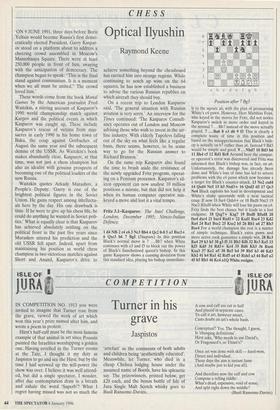CHESS
Optical Ilyushin
Raymond Keene
`ON 9 JUNE 1991, three days before Boris Yeltsin would become Russia's first demo- cratically elected President, Garry Kaspar- ov stood on a platform about to address a cheering crowd assembled in Moscow's Manezhnaya Square. There were at least 250,000 people in front of him, swaying with the anticipation of democracy. The champion began to speak: "This is the final stand against communism. It is a moment when we all must be united." The crowd loved him.'
These words come from the book Mortal Games by the American journalist Fred Waitzkin, a stirring account of Kasparov's 1990 world championship match against Karpov and the political events in which Kasparov was caught up. These include Kasparov's rescue of victims from mas- sacres in early 1990 in his home town of Baku, the coup against Gorbachev of August the same year and the subsequent demise of the USSR. As Waitzkin's book makes abundantly clear, Kasparov, at that time, was not just a chess champion but also an idealist with genuine prospects of becoming one of the political leaders of the new Russia.
Waitzkin quotes Arkady Murashov, a People's Deputy: 'Garry is one of the brightest political figures in the Soviet Union. He gains respect among intellectu- als here by the day. His one drawback is time. If he were to give up his chess life, he could do anything he wanted in Soviet poli- tics.' What is equally clear is that Kasparov has achieved absolutely nothing on the political front in the past five years since Murashov uttered his prediction and the old USSR fell apart. Indeed, apart from maintaining his position as world chess champion in two victorious matches against Short and Anand, Kasparov's drive to achieve something beyond the chessboard has carried him into strange regions. While continuing to notch up wins on the 64 squares, he has now established a business to advise the various Russian republics on which aircraft they should buy.
On a recent trip to London Kasparov said, 'The general situation with Russian aviation is very sorry.' An interview for the Times continued: 'The Kasparov Consult- ancy operates out of London and Moscow advising those who wish to invest in the air- line industry. With elderly Tupolevs falling out of the sky on what feels like a regular basis, there seems, however, to be some way to go for the Russian answer to Richard Branson.'
On the same trip Kasparov also found the time to brush aside the resistance of the newly upgraded Fritz program, operat- ing on a Pentium processor. Kasparov's sil- icon opponent can now analyse 10 million positions a minute, but that did not help it when its human computer operator mis- keyed a move and lost it a vital tempo.
Fritz 3.1—Kasparov: The Intel Challenge, London, December 1995; Nimzo-Indian Defence.
1 d4 Nf6 2 c4 e6 3 Nc3 Bb4 4 Qc2 0-0 5 a3 Bxc3+ 6 Qxc3 b6 7 Bg5 (Diagram) In this position Black's normal move is 7 ...Bb7 when White continues with e3 and f3 to block out the power of Black's fianchettoed queen's bishop. In this game Kasparov shows a cunning deviation from this standard idea, playing his bishop immediate- Position after 7 Bg5
ly to the square a6, with the plan of pressurising White's c4 pawn. However, Herr Matthias Feist, who keyed in the moves for Fritz, did not notice Kasparov's switch in move order and keyed in the normal 7 ... Bb7 instead of the move actually played. 7 ...Ba6 8 e3 d6 9 t3 This is clearly a complete waste of time in this position and based on the misapprehension that Black's bish- op is actually on b7 rather than a6. Instead 9 Bd3 would be simple and good. 9 ...Nbd7 10 Bd3 h6 11 Bh4 c5 12 Rdl Rc8 Around here the comput- er operator's error was discovered and Fritz was informed that Black's bishop was, in fact, on a6. Unfortunately, the damage has already been done and White's loss of time has led to severe problems with the c4 pawn which now become s a target for Black's counter-attack. 13 Ne2 cxd4 14 Qxd4 Ne5 15 b3 Nxd3+ 16 Qxd3 d5 17 Qc3 Ne4 Black exploits his lead in development and White's shaky queenside with a neat tactical coup. If now 18 fxe4 Qxh4+ or 18 Bxd8 Nxc3 19 Nxc3 Rfxd8 when White will lose his pawn on c4. Fritz finds the best chance but it leads to a lost endgame. 18 Qxg7+ Kxg7 19 Bxd8 Rfxd8 20 fxe4 dxc4 21 bxc4 Rxdl+ 22 Kull Rxc4 23 Kd2 Ra4 24 Ral Bxe2 25 Kxe2 b5 26 Rbl a6 27 Rb3 Rxe4 For a world champion the rest is a matter of simple technique. Black's extra pawn and more active rook guarantee a simple win. 28 Rc3 Ra4 29 h3 h5 30 g315 31 Rb3 Kf6 32 Rc3 Key 33 KO Kd5 34 Rd3+ Kc4 35 Rd6 Kb3 36 Rxe6 Kxa3 37 Ke2 a5 38 Re5 b4 39 Rb5 b3 40 Kd3 Kb2 41 h4 Ral 42 RxfS a4 43 RxhS a3 44 Ra5 a2 45 h5 Rhl 46 Kc4 alQ White resigns.


















































 Previous page
Previous page